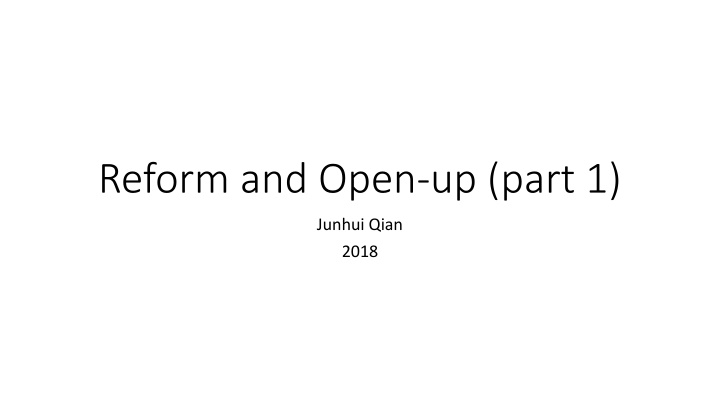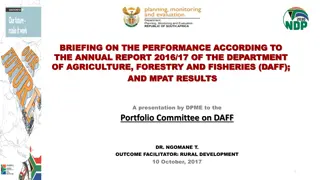Reform and Open-up: The Evolution of Chinese Rural Economy
This article delves into the historical background and key events that shaped the reform and open-up policies in China, focusing on the transformation of the countryside, the rise of Township and Village Enterprises (TVEs), and the implementation of the Household Responsibility System (HRS). It discusses the factors behind the success and limitations of these reforms, highlighting the shift towards a more pragmatic approach to economic development. Through a series of experiments and adjustments, China navigated the complexities of socialist ideology while embracing market-oriented reforms to drive economic growth.
Download Presentation

Please find below an Image/Link to download the presentation.
The content on the website is provided AS IS for your information and personal use only. It may not be sold, licensed, or shared on other websites without obtaining consent from the author.If you encounter any issues during the download, it is possible that the publisher has removed the file from their server.
You are allowed to download the files provided on this website for personal or commercial use, subject to the condition that they are used lawfully. All files are the property of their respective owners.
The content on the website is provided AS IS for your information and personal use only. It may not be sold, licensed, or shared on other websites without obtaining consent from the author.
E N D
Presentation Transcript
Reform and Open-up (part 1) Junhui Qian 2018
Outline The reform of the countryside The rise of TVE The dual-track system
Questions How was reform started? What were the factors behind the immediate success of the rural reform? What were the limitations of the HRS? What factors were behind the rapid development of township and village enterprises (TVE)? How were private enterprises legalized in a socialist country? Why was the dual-track approach popular? And how did it work? Was gradualism a design, or a product of recurring battle between reformers and conservatives.
Background of the Reform Domestic New leaders were much less ideological than their predecessors. Living condition stagnated for a long time (a lost two decades), especially the farmers. Improved relation with the US helped to look outward for new ideas. International Most planned-economy countries experienced similar economic stagnation. The market economies of East Asia Tigers (Hong Kong, Singapore, South Korea, and Taiwan) experienced high growth. Ideological shift to the right (US & UK)
It Started from the Countryside In desperate situations, local cadres and farmers experimented new institutional arrangements to increase output. In one notable example, 20 households in Xiao Gang Village ( ), Feng Yang of Anhui Province ( ), chose to use an old scheme: production contract at the household level ( ). This scheme was experimented in 1961 and was very successful. But it was considered capitalistic and thus forbidden. In 1978, however, the farmers won the political gamble. The provincial leader approved the practice.
Household Responsibility System There were many other schemes that were experimented in different areas. But the one experimented in Xiao Gang Village eventually became the norm, with the name Household Responsibility System (HRS, ). Farm households took over management of a specific plot of land, subject to a contractual agreement that they turn over a certain amount of procurement (low price) and tax (zero price) grain after the harvest. The solution was controversial, but it received support from the leadership. After all, it was not a privatization.
Problems the HRS Solved Lack of incentives In HRS, farmers keep the residual profit Asymmetric information in supervision Process supervision Result supervision Due to the lack of incentives and the difficulty of supervision, farm collectives were unable to realize the scale of economy.
The Limitation of HRS Reduced the scale of farm operation. Land fragmentation. Rigid rules for land transfers. Weak property rights on the contracted land. Hinders investment for long-term growth. Unable to use land as collateral. Unable to use land as an instrument for saving.
The Immediate Result By 1984 grain output had surged to 407 million tons, more than one third higher than in 1978, and farmers actually reduced working days. There was enough grain for everybody in China, and the history of shortage of food was over!
One Success Leads to Another The instant success of the agricultural reform strengthened the position of the reformers, on the top and down in the grassroots. Rural enterprises were allowed to grow and prosper. The rising income of farmers Drove up demand for consumer goods. Provided savings for continued investment. The rising productivity of farming released labor supply Rural enterprises further enriched farmers, creating a virtuous circle.
Outline The reform of the countryside The rise of TVE The dual-track system
The Rise of Township and Village Enterprises (TVE) Starting in the 1950s and continuing through the 1970s, rural communes and brigades were encouraged to develop collectively owned industrial enterprises, which were later called TVE s. Fiscal reform in 1980s gave local governments the scope to develop and rights to retain revenues from TVE s. TVE s were outside the production plan. They were allowed to produce and market goods in shortage, and even to compete with some of the existing state-owned enterprises. Although some SOE s faced more competition, most benefited from the rising demand for consumer and industrial goods. Hence the agricultural reform and the development of TVE was a Pareto improvement.
Different Models of TVEs Southern Jiangsu Model Organized by collectives (with some capable leaders), capital intensive manufacturing, relatively closed to migrant workers. Wenzhou Model Private small businesses, high degree of division of labor, Pearl Delta Model Foreign, or foreign-collective jointly owned, trade processing, open to migrant workers.
Legitimization of Private Ownership Some entrepreneurs disguised their firms as collectives, thus gaining the shelter of a red hat that falsely signified public rather than private ownership; others purchased informal protection from powerful individuals or agencies. A succession of amendments to China s 1982 constitution slowly expanded recognition of the non-state economy. complement to the state sector (1988) important component (1999) of the socialist market economy (itself a new term dating from 1993). The Law on Solely Funded Enterprises, which took effect in 2000, guarantees state protection for the legitimate property of such firms, but without using the term private or specifying any agency or process to implement this guarantee. citizens lawful private property is inviolable. (2004) 2007: Law on Property Rights, for the first time, explicitly places privately held assets on an equal footing with state and collective property.
Outline The reform of the countryside The rise of TVE The dual-track system
Dual-Track System The reform was carried out without a grand blueprint. The old plan- economy rules and institutions were maintained, while the market approach was experimented, first in the rural and then in the cities. The dual-track system was an important feature in the Chinese transition from the planned economy to a market economy. In a dual-track system, there were typically two prices, one official (nominal, plan) and the other market price. Producers, after fulfilling the requirements of the planner (or procurement target for the farmer), could sell their products to the market at market prices. In sourcing for factor inputs (energy, materials, etc.), producers could purchase more than the planner allowed from the market at market prices.
The Reach of Dual-Track Approach The dual-track approach was taken everywhere Grains Materials and energy Labor Foreign exchange Loans Shares (tradable and non-tradable) The approach is still popular today.
Price of Grain Coupons There were two prices for grains, the negotiable price ( ) and the nominal price ( ). The former reflects market condition and is generally higher than the latter, which is determined by the local government. With grain coupons, one can buy grains at the nominal price, in effect enjoying the government subsidy. In 1980s, the grain consumption of urban residents declined, thanks to more consumption of non-grain food (meat, egg, etc.). As the quantity of grain coupon issued to urban families changed little, a grey market emerged to exchange grain coupons. On the demand side of the grain coupons, there were Migrant workers Enterprises that use grains as inputs (e.g., liquor-making)
Profiteers of the Dual-Track System The existence of two prices for one commodity brought a large number of profiteers or arbitragers ( ). Profiteers could obtain quotas from some government agency to purchase some commodity (e.g., coal, steel) at the plan price and then re-sell it to the market at market price, harvesting huge profit instantly. For those with deep connections with the planning agency, there was a more accurate name for these profiteers: official profiteers ( ).
The Pain of Transition The widespread profiteering, along with recurrent inflation, undermines the political support for the reform. The periodic retrenchment of reform made economic cycles more volatile Once loosen, chaos; once tighten, death. ( ) Two steps forward, one step back.
The Cycle of Reform-Retrenchment When important reform was carried out, which invariably came with some decentralization of decision making on investment, demand would outpace supply. Inflation rose. As commodity prices rose, profiteering also intensified. Then the central government would cut investment projects, often by re-centralization and reign in reform experiments. The economy would then cool down dramatically. As there was no alternatives, reform would be restarted after a period of economic malaise.
Growth Despite Gradualism Gradualism of Chinese reform is not by design, but a product of the shifting balance of power between the reformers and the conservatives. Despite the slow reform in 1980s and early 1990s, China achieved rapid growth because Market force, once allowed, strengthened itself. As international trade and investment was encouraged, export-led growth started, taking advantage of the extremely low cost of labor.























